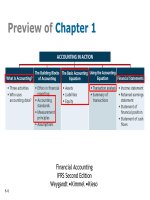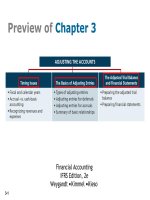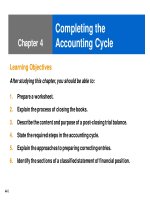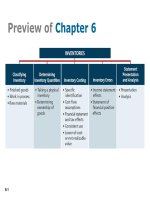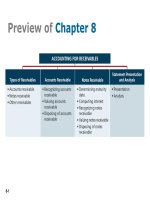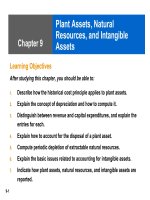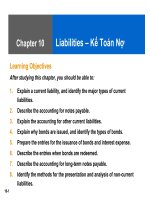financial accounting chapter 02 the recording process
Bạn đang xem bản rút gọn của tài liệu. Xem và tải ngay bản đầy đủ của tài liệu tại đây (1.01 MB, 38 trang )
2-1
Preview of Chapter 2
Financial Accounting
IFRS Second Edition
Weygandt Kimmel Kieso
2-2
Record of increases and decreases
in a specific asset, liability, equity,
revenue, or expense item.
Debit = “Left”
Credit = “Right”
Account
Account
An account can be
An account can be
illustrated in a T-
illustrated in a T-
account form.
account form.
LO 1 Explain what an account is and how it helps in the recording process.
The Account
2-3
Double-entry system
►
Each transaction must affect two or more accounts to
keep the basic accounting equation in balance.
►
Recording done by debiting at least one account and
crediting another.
►
DEBITS must equal CREDITS.
LO 2 Define debits and credits and explain their use
in recording business transactions.
The Account
Debits and Credits
2-4
Account Name
Debit / Dr.
Credit / Cr.
If Debit amounts are greater than Credit amounts, the
account will have a debit balance.
$10,000 Transaction #2$3,000
$15,000
$15,000
8,000Transaction #3
Balance
Transaction #1
Debits and Credits
LO 2 Define debits and credits and explain their use
in recording business transactions.
2-5
Account Name
Debit / Dr.
Credit / Cr.
$10,000 Transaction #2$3,000
Balance
Transaction #1
$1,000
$1,000
8,000 Transaction #3
If Debit amounts are less than Credit amounts, the
account will have a credit balance.
Debits and Credits
LO 2 Define debits and credits and explain their use
in recording business transactions.
2-6
Assets - Debits should exceed
credits.
Liabilities – Credits should
exceed debits.
Normal balance is on the
increase side.
Debits and Credits
LO 2 Define debits and credits and explain their use
in recording business transactions.
2-7
Issuance of share capital and
revenues increase equity (credit).
Dividends and expenses
decrease equity (debit).
Debits and Credits
LO 2
2-8
Debits and Credits
LO 2 Define debits and credits and explain their use
in recording business transactions.
The purpose of earning
revenues is to benefit the
shareholders.
The effect of debits and credits
on revenue accounts is the
same as their effect on equity.
Expenses have the opposite
effect: expenses decrease
equity.
2-9
Normal
Balance
Credit
Normal
Balance
Credit
Normal
Balance
Debit
Normal
Balance
Debit
Debit/Credit Rules
LO 2
2-10
Income Statement
=
+
-
Asset Liability Equity Revenue Expense
Debit
Credit
Debit/Credit Rules
LO 2 Define debits and credits and explain their use
in recording business transactions.
Statement of
Financial Position
2-11
Debits:
a. increase both assets and liabilities.
b. decrease both assets and liabilities.
c. increase assets and decrease liabilities.
d. decrease assets and increase liabilities.
Debit/Credit Rules
Question
LO 2 Define debits and credits and explain their use
in recording business transactions.
2-12
Accounts that normally have debit balances are:
a. assets, expenses, and revenues.
b. assets, expenses, and equity.
c. assets, liabilities, and dividends.
d. assets, dividends, and expenses.
Debit/Credit Rules
Question
LO 2 Define debits and credits and explain their use
in recording business transactions.
2-13
Kate Browne, president of Hair It Is, Inc., has just rented space in a
shopping mall in which she will open and operate a beauty salon. A
friend has advised Kate to set up a double-entry set of accounting
records in which to record all of her business transactions. Identify
the balance sheet accounts that Hair It Is, Inc., will likely need to
record the transactions needed to establish and open the business.
Also, indicate whether the normal balance of each account is a debit
or a credit.
LO 2
Assets
Cash (debit)
Supplies (debit)
Equipment (debit)
Liabilities
Notes payable (credit)
Accounts payable (credit)
Equity
Share capital (credit)
2-14
Business documents, such as a sales slip, a check, a bill, or
a cash register tape, provide evidence of the transaction.
LO 3 Identify the basic steps in the recording process.
Illustration 2-13
Analyze each transaction Enter transaction in a journal
Transfer journal information to
ledger accounts
Steps in the Recording Process
2-15
Team Quiz #1
2-16
2-17
Team Quiz #2
2-18
Team Quiz #3
2-19
Book of original entry.
Transactions recorded in chronological order.
Contributions to the recording process:
1. Discloses the complete effects of a transaction.
2. Provides a chronological record of transactions.
3. Helps to prevent or locate errors because the debit and
credit amounts can be easily compared.
LO 4 Explain what a journal is and how it helps in the recording process.
Steps in the Recording Process
The Journal
2-20
Journalizing - Entering transaction data in the journal.
LO 4 Explain what a journal is and how it helps in the recording process.
Illustration: On September 1, shareholders’ invested €15,000
cash in the corporation in exchange for share of stock, and Softbyte
purchased computer equipment for €7,000 cash.
Cash
Share capital-ordinary
Sept. 1
15,000
15,000
General Journal
Equipment
Cash
7,000
7,000
Illustration 2-14
Steps in the Recording Process
2-21
Simple and Compound Entries
LO 4 Explain what a journal is and how it helps in the recording process.
Illustration: On July 1, Tsai Company purchases a delivery truck
costing NT$420,000. It pays NT$240,000 cash now and agrees to
pay the remaining NT$180,000 on account.
Equipment
Cash
July 1
420,000
240,000
General Journal
180,000
Accounts payable
Illustration 2-15
Steps in the Recording Process
2-22
Team Quiz #4
2-23
2-24
General Ledger contains the entire group of accounts
maintained by a company.
LO 5 Explain what a ledger is and how it helps in the recording process.
Illustration 2-16
The Ledger
Steps in the Recording Process
2-25
LO 5 Explain what a ledger is and how it helps in the recording process.
Illustration 2-17
Steps in the Recording Process
Standard Form of Account

